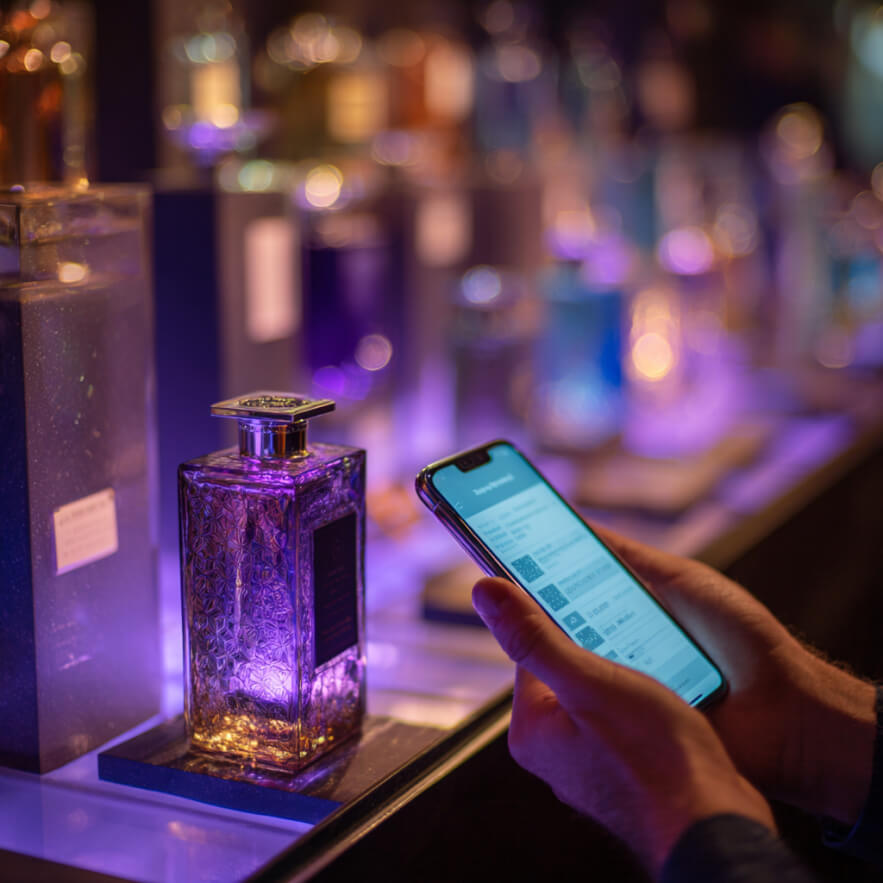When fragrance meets digital technology, surprising and practical solutions emerge. Brands aim not only to sell bottles but to build more honest, transparent, and personalized relationships with their customers. At the intersection of blockchain, Internet of Things (IoT), and perfume production, a new space is emerging—where each scent becomes more than a product and turns into part of a protected digital story.
Transparency of origin: Blockchain as a guarantee of authenticity
One of the biggest challenges in perfumery is the counterfeit market. Luxury brands lose millions to knock-offs, and customers risk buying cheap imitations disguised as originals. The implementation of blockchain technology addresses this problem by creating a traceable chain of custody that cannot be erased or altered. Each bottle is assigned a unique digital ID, and its entire journey—from production to the point of sale—is recorded in a distributed database.
This shifts the whole concept of trust. A customer can now scan a QR code on the packaging and instantly see where the perfume was made, who supplied the ingredients, and which lab blended the formula. Italian brand Masque Milano already uses such a system, allowing each item to be “tracked” via their app. Linking products to blockchain not only certifies authenticity but turns a purchase into a digital act of participation—you’re buying into a verified story.
It also helps brands fight grey-market imports. Since blockchain tracks not just production date but region-specific data, any mismatch in geographic flow is flagged. If a bottle meant for the Asian market appears in a European shop, it’s traceable. Retailers can’t blame logistics errors—data is immutable. While this infrastructure requires investment, the return comes in the form of consumer trust and brand loyalty.
IoT and smart bottles: When perfume speaks for itself
Internet of Things (IoT) has made its way into the fragrance industry. Increasingly, perfume bottles are being equipped with sensors and microchips that can monitor usage, suggest replacements, and in some cases—even adjust the scent depending on the user’s mood or local weather. One pioneer in this space is French company Ninu, whose bottles sync with a mobile app and allow users to tweak the formula through their smartphones.
For consumers, this creates a whole new interaction. Perfume was once a one-time emotional purchase. Now, the bottle becomes a personal device, adapting to daily life. For example, in the morning, the app can release a light citrusy blend, and in the evening, a warmer, woodier note—without changing the bottle. Everything is personalized and responsive, based on user preferences and external factors.
This setup also offers valuable feedback to brands. By collecting anonymous data on how, when, and where fragrances are used, companies gain deeper insights into seasonality, regional tastes, and even application habits. While data privacy is a concern, most users are willing to share this type of usage data in exchange for more personalized scent experiences.
NFTs and digital fragrances: Taking uniqueness beyond the bottle
When blockchain becomes part of perfumery, it naturally leads to NFT-based scents—digital tokens tied to unique fragrance compositions. What began with digital fashion and art is now spreading to fragrance. For instance, brand Look Labs released a digital version of its Cyber Eau de Parfum, encoding the scent’s molecular structure and selling it as an NFT. It’s not a replacement for the physical product but a digital fingerprint tied to it.
This model appeals to collectors and brand superfans. A unique digital certificate proves that you own more than a bottle—you’re part of a limited-edition digital experience. In the future, we may see NFT fragrance launches that include exclusive content, restock rights, or early access to new collections. This creates a hybrid interaction model: collecting, gamification, and community engagement.
There are also practical benefits. NFTs can be linked to real bottles for supply chain traceability, IP protection, or loyalty programs. Owners might gain access to private sales or virtual lab tours. It’s no longer sci-fi—real-world applications are being built by developers, fragrance houses, and designers experimenting at the edge of tech and scent.
Smart contracts and logistics: Digital systems reduce losses
Smart contracts are another digital tool gaining traction in perfume supply chains. These self-executing agreements automate steps in the journey from manufacturer to consumer. Unlike traditional paperwork, smart contracts don’t need intermediaries: once conditions are met, payment is transferred, delivery is confirmed, and every step is logged. This reduces errors and streamlines logistics.
For large fragrance houses, this means real-time inventory tracking, especially important in luxury segments where accuracy matters. Blockchain and IoT integration allow for monitoring of transit conditions—temperature, humidity, and vibration. If a perfume shipment was exposed to poor conditions, the system can automatically flag it before it reaches the shelf.
This technology is particularly useful in e-commerce, where returns and disputes are frequent. Smart contracts record everything—packing date, dispatch time, storage conditions. If a customer complains, the entire record is verifiable instantly, without hours of phone calls or video footage. It builds trust and helps small brands lower costs while selling on marketplaces or direct-to-consumer channels.
User experience and engagement: Digital tools serving emotion
Digitization doesn’t just simplify processes—it deepens emotional connection with the brand. In a crowded market, consumers want to feel seen and valued. That’s why perfume houses are integrating personalization features: from preference quizzes and name engraving to dynamic scent suggestions based on behavior. These all run on digital systems, where even tiny details count.
IoT-enabled bottles can sync with calendars or weather apps, recommending specific fragrances for specific days. For instance, a warm, spicy scent might be suggested on rainy mornings, while a crisp minty one fits a sunny afternoon. This turns perfume into a personal scent advisor, helping users make conscious and emotionally satisfying choices. Some brands are even exploring voice assistant integrations that help users select fragrances before leaving home.
This isn’t about trend-chasing. Customers are expecting more than just fragrance—they want an experience that feels curated and emotionally rewarding. A bottle gains more meaning when it becomes part of a life story rather than an object on a shelf. Brands that deliver this connection win long-term trust and relevance.
What you need to know about digital fragrance today
- Blockchain protects against counterfeits by logging bottle origins
- IoT turns perfume bottles into smart, user-adaptive devices
- NFTs offer new forms of ownership and digital collection
- Smart contracts improve logistics and reduce manual errors
- Personalization features make fragrance part of daily life
Want to see how technology transforms production too? Explore“Modularity in mechanical engineering: how standardized blocks accelerate production” for insights on standards, flexibility, and smart factory design.
It tracks the origin of each scent and guarantees authenticity, preventing counterfeits.
It monitors usage, adjusts scents based on conditions, and integrates with apps.
To confirm uniqueness, enable collection, and add digital value to physical fragrances.

